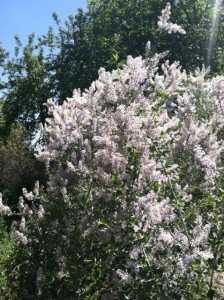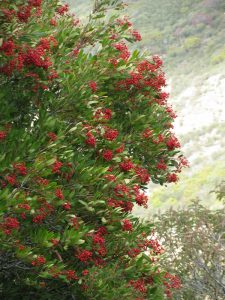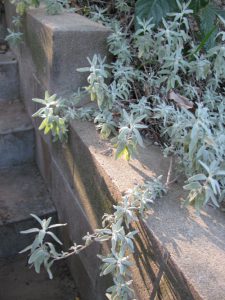Our California native plants are hanging in for the winter — undoubtedly hoping for some real winter rains. In the meantime, for many it’s the time of year to do some pruning. There are exceptions (see below) but pruning in the winter months before new growth starts is often recommended. Here are some takeaways that we’ve employed – mostly from the book Care and Maintenance of Southern California Native Plant Gardens, by Bart O’Brien, et al, along with some tips we’ve learned the hard way.
Some terminology for novices: pinching is removing the tip of a growing branch, and results in side branching at the point. When pruning, use sharp pruners that are sterilized (we occasionally wipe with rubbing alcohol) and cut near to the main branch or trunk (don’t leave stubs).
Shrubs

Ceanothus: Pinch and lightly prune in spring after flowering and when they’re producing active growth. Never cut into old growth that is larger than a pencil (the cuts heal slowly and are susceptible to apricot dieback fungus). A happy ceanothus that has flowered heavily will have sections of stems without leaves or branches so you can cut back old flowered clusters for a denser look.
Lemonadeberry (Rhus integrifolia): Pinch young plants to encourage denser growth. If used for a hedge, O’Brien says it can be sheared 2-3 times a year but avoid severe pruning.
Manzanitas (Arcostaphylos spp): Do not prune during cool, wet winter months because of fungus pathogens. Pinch back young manzanitas when there is new growth (usually March, April). Older plants can be pruned up or thinned to reveal branching patterns in late summer, but because exposing formerly shaded portions can lead to sunscald it’s better to do this slowly over years. We have not pruned our manzanitas at all – and they look great!

Toyon (Hetermeles arbutifolia): Young trees should be pinched to develop a fuller appearance if desired, or leave as is if you desire a tree shape. The optimal pruning time is winter before new growth starts. You can also prune or pinch back in mid to late spring but be careful to not take off flower buds, or you’ll be without flowers and the beautiful red berries.
Shrubs to not prune and never cut into old growth:
- Fremontia
- Sugar Bush (Rhus ovata) are beautiful large shrubs (we have an old one 20 feet by 20 feet). They also make good hedges but don’t prune heavily and best to do in early fall.
- Hollyleaf Cherry (Prunus ilicifolia) only needs pinching if anything.
Subshrubs
California Fuchsia (Zauschneria or Epilobium spp): This plant needs to get established before pruning so don’t prune hard until it’s a couple years old, Then cut back hard every winter after the plant has finished blooming and new growth appears. It seems severe but you can cut back to short 1-2 inches stubs. O’Brien suggests light fertilizing a month or so after pruning if growing in infertile soils.
Matilija Poppy (Romneya coulteri): O’Brien says if growing vigorously after a year, prune hard, cutting back all the old stems to stubs only 3-4 inches from the ground. But don’t prune back new shoots that have appeared.
Sagebrush (Artemesia spp): Prune in early winter before new growth, and do not cut into old growth because it may not resproutt:other sagebrushes should be pinched to promote branching.
Groundcover salvias like Bee’s Bliss can be pinched to add denseness

Salvias (sages): Prune in late fall or early winter – before or as new growth begins. If you prune later you may remove developing flowers. Pinch young plants to get denser, fuller habit. Some sages (Cleveland and its hybrids such as Allen Chickering, Pozo Blue, Aromas) and Purple sage (Salvia leucophylla) can be cut back 1/4 to 1/3rd but avoid older(Cleveland up to one-half). One exception is White Sage below. A mistake for us: we waited too many years before pruning our Cleveland Sage and it’s gotten too leggy and pruned older stalks never resprout. Pay more attention to structure early.
Monkeyflower (Mimulus spp) – Pinch young, actively growing plants to shape a dense branching structure, necessary to support the flower stocks. After blooming, remove the entire flower stalk. If you cut off all the flower stalks, and water, monkeyflowers will rebloom in the summer. Monkey flowers can be pruned in late fall before new growth appears.
The following should not be pruned:
- Buckwheat (Erigonium spp.) – deadhead plants is all that is necessary. And pinching when young to shape. However, cuts into old growth likely won’t resprout (we learned the hard way)
- White Sage (Salvia apiana) – needs no pruning, just remove old flower stalks. However, pinch young plants to promote fuller, denser habit.
Trees
California Sycamore (Platanus racemosa) – like other deciduous trees, prune in winter during dormancy. Never cut large branches or trunks “which undermines the structural integrity of the tree” writes O’Brien.
Coast Live Oak should not be overpruned.
Coast Live Oaks (Quercus agrifolia): Don’t overprune. Prune in summer to early fall (mid-July-September). Pruning in winter and spring causes an abundance of new growth near the pruning site and takes months to recover. Minimize the amount taken, removing dead branches periodically. Young trees can benefit from pruning to establish good branching. Engelmann Oaks (Quercus engelmannii) need little to no pruning.
Other deciduous native trees such as desert willow, white alder Chitalpa, California Walnut, , Cottonwood, Mexican Elderberry, Willow: Prune in winter during dormancy.
Others
Deergrass (Muhlenbergia rigens): Does best when cut back in May or June (along with fertilizing and watering)
Yucca: Prune after blooming, in late spring or early summer. Do not prune in winter through early spring because pruning cuts won’t heal.
For others plants I didn’t cover, please buy the book, Care and Maintenance of Southern California Native Plant Gardens, by Bart O’Brien, et al, – we’ve found it very helpful. Or I’m available to look up a quick one.
Helpful and thank you. Paula wants me to prune correctly :)
As you should… glad it was helpful….!